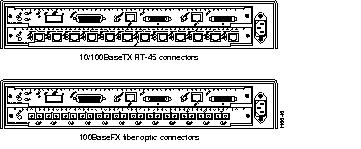|
|

This chapter describes the procedures needed to make all external cable connections to the Catalyst 2900 at your site.
The following guidelines will assist you in properly connecting the external network cables to your switch.
 | Warning A voltage mismatch can cause equipment damage and may pose a fire hazard. If the voltage indicated on the label is different from the power outlet voltage, do not connect the chassis to that receptacle. To see translated versions of this warning, refer to the appendix "Translated Safety Warnings." |
If the switch fails to operate in the manner specified in the publication Catalyst 2900 Series Configuration Guide and Command Reference, refer to the chapter "Confirming the Installation" to help isolate the problem, and then notify a customer service representative.
The sections that follow provide illustrations of the connections between the switch interface ports and your network(s). Interface cables and equipment, such as Ethernet transceivers and interface cables, should already be available and in place. If they are not, refer to the following section "Ethernet Connections" for descriptions of the equipment you need for each interface type to complete the connection to your network.
Most Ethernet connections do not require a transceiver on the interface cable. On the 10/100BaseTX switching module port, attach the cable connector, and secure the cable in the port and use a tie-wrap to provide strain relief. 100BaseTX Fast Ethernet connections to the MII connector on the supervisor engine module require a Fast Ethernet transceiver with a transceiver cable. Figure 4-1 shows two Catalyst 2900s, one with 12 100BaseFX ports and the supervisor engine module, and one with 12 10/100BaseTX ports and a supervisor engine module. For descriptions of the connection equipment and connector locks, refer to the section "Ethernet Connection Equipment" in the chapter "Installation Overview."

The supervisor engine module console port supports a DCE EIA/TIA-232 interface type and mode. For descriptions and illustrations of each connector type, refer to the section "Console Port Connection Equipment" in the chapter "Installation Overview." For cable pinouts, refer to the appendix "Cabling Specifications."
When connecting a serial device, consider the cable as an extension of the switch for an external connection. Therefore, use null-modem cable to connect the switch to a remote DCE device such as a modem or DSU, and use a straight-through cable to connect the switch to a DTE device such as a terminal or PC. (See Figure 4-2.)

The system console port on the supervisor engine module is a DCE DB-25 receptacle for connecting a data terminal, which you will need to configure and communicate with your system. The port is located on the supervisor engine module faceplate and is labeled Console, as shown in Figure 4-3.

Before connecting the console port, check your terminal's documentation to determine the baud rate. The baud rate of the terminal must match the default baud rate (9600 baud) of the terminal you will be using. Set up the terminal as follows:
Use the proper null-modem or straight-through cable to connect a terminal or modem to the console port on the supervisor engine module, then follow the steps in the next section, "Starting the System."
When all interfaces are connected, perform a final check of all connections, then take the following steps to check the components and power up the system.
Step 1 Check the following components to make sure they are secure:
Step 2 Plug in the power cord.
The PS LED on the supervisor engine module faceplate will be green.
Step 3 Listen for the system fan assembly and check the fan LED on the supervisor engine module. You should immediately hear it start operating.
Step 4 While the system initializes, the status LED on the supervisor engine module is orange until the boot is complete. Refer to the chapter "Confirming the Installation" for troubleshooting procedures.
During the boot process, the status LED on all interfaces is orange. Some LEDs may go on and remain on or go out and go on again for a short time. Some LEDs, such as the link LED, will stay on during the entire boot process. If an interface is already configured, the LEDs may go on steadily as they detect traffic on the line. Wait until the system boot is complete before attempting to verify the switching module LED indications.
When the system boot is complete (it takes a few seconds), the supervisor engine module begins to initialize the switching modules. During this initialization, the LEDs on each switching module behave differently (most flash on and off). The status LED on each switching module goes on when initialization has been completed, and the console screen displays a script and system banner similar to the following:
BOOTROM Version 2.1, Dated May 22 1996 15:17:09
Boot date: 05/22/96 BOOT time: 15:17:09
Executing from RAM
Cisco Systems Console
Sending RARP request with address 00:40:0b:a0:05:b8
Sending bootp request with address 00:40:0b:a0:05:b8
Sending RARP request with address 00:40:0b:a0:05:b8
Sending bootp request with address 00:40:0b:a0:05:b8
No bootp or rarp response received
Enter password:
Step 5 At the password prompt, press Return. To add password protection, refer to the chapter "Configuring the Software." The following prompt will appear:
Console>
Many of the switching module LEDs will not go on until you have configured the interfaces. To verify correct operation of each interface, complete the first-time startup procedures and configuration, then refer to the LED descriptions in the chapter "Confirming the Installation" to check the status of the interfaces.
Your installation is now complete. Refer to the chapter "Configuring the Software" or refer to the publication Catalyst 2900 Configuration Guide and Command Reference for additional information, if needed.
|
|